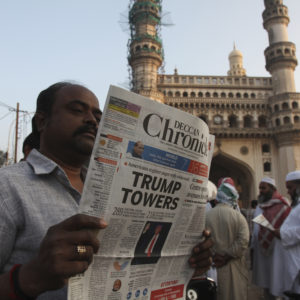More than 40 years ago, Japan flooded the U.S. market with inexpensive small cars — their manufacture directly subsidized by the government of Japan, their manufacturers working in close concert with the government of Japan.
Meanwhile, American cars were effectively locked out of the Japanese market via stiff import tariffs, a type of tax designed specifically to raise artificially the cost of a product in order to make it a tougher sell in the home market vs. domestically made competitor products.
In the 1990s, whole industries were offshored to the People’s Republic of China under the rubric of “free trade,” which was anything but. China is an authoritarian communist state in which workers do as they are told — for peanuts — or else.
Cheap — and this time, cheaply made — goods began to flood the U.S. market.
Whole sectors of the American economy disappeared and millions of Americans lost their good-paying jobs in exchange for low prices at Walmart.
Now comes India.
Under Prime Minister Narendra Modi, the country is pursuing a similarly aggressive policy of unfair trade called Make in India. It has multiple meanings.
First, the government is soliciting foreign investment by dangling the prospect of artificially low labor costs as well as a lax — by Western standards — regulatory regime. This is an issue of major importance to manufacturing, which has become much more costly in the United States due to extremely strict — and extremely expensive — environmental compliance and worker safety requirements.
Thus, American aviation giant Boeing was induced to build — of all things — the military’s F/A Super Hornet fighter in India rather than America. The new F/A 18 plant will “mirror” the Super Hornet production line that still exists (for now) in St. Louis, Missouri — in terms of the way the aircraft are assembled.
But the jobs will go to Indians — and the Indian-made F/A-18s will then be bought by Americans, using American taxpayer dollars.
How this benefits America is hard to understand.
Modi’s government has targeted 25 specific industries — including the car industry — for his Make in India juggernaut. Not many people outside the industry know it, but British car maker Jaguar Land Rover is owned by the Indian conglomerate Tata Motors — and the jobs formerly held by workers in the United Kingdom are now held by workers in India.
General Motors, which already has made considerable investment in China, will surely be tempted to ramp up operations in India as well. Maybe Ford, too.
This is big-time stuff. India is now the No. 1 destination for foreign investment in manufacturing, eclipsing China.
But it’s not just making things in India that’s at issue.
Modi’s government is also using extraordinarily punitive tariffs to keep goods out of India that weren’t made there.
For example, India slaps tariffs of 60 percent to 70 percent on American-made motor vehicles (including Harley Davidson motorcycles), a 70 percent tariff on imported rubber, a 50 percent to 113 percent on certain made-in-the-USA agricultural products, a 150 percent tariff on U.S.-made alcoholic beverages and a 300 percent tariff on certain textiles. See here for more details.
Last year, telecommunications and medical equipment were targeted for special treatment. U.S.-made stents and pacemakers got slapped with a 12.5 percent “additional duty” and on top of that a 4 percent “special additional” duty. These two new duties were levied in addition to the existing 7.5 percent “basic” duty. Thus, the India-price of U.S.-made surgical devices is artificially jacked up by almost 25 percent — which gives an unfair trade advantage to Indian-made medical equipment.
It’s actually more than 25 percent.
Because in addition to the tariffs levied by the national government, individual Indian states have their own supplementary value-added/sales taxes, which apply only to imported goods.
The really crazy thing, though, is that goods made in India are still given indulgently preferential treatment when they are shipped to America under the rubric of something called the General System of Preferences (GSP) under which India is still considered a “developing country.”
Which it was … back in 1976, when the GSP came into being.
The result — today — is a $13 billion and growing trade deficit between the United States and India, which benefits from its disco-era GSP status to the tune of almost $4.8 billion annually. It is currently the No. 1 beneficiary of outdated GSP favoritism — which is sorely in need of re-evaluation given India’s development since 1976.
That is slated to happen toward the end of the month, when the Trump administration will decide whether India — and other no-longer “developing” countries — should continue to be permitted to sell their home-market-manufactured goods here at a discount while our manufactured goods get hit over the head with obnoxious tariffs when sold over there.
On the campaign trail, the president promised he’d make sure America would not be “taken advantage of anymore” by unfair trade practices. He has an opportunity to do exactly that, right around Christmastime.
It’d be a nice thing to find under the tree.

